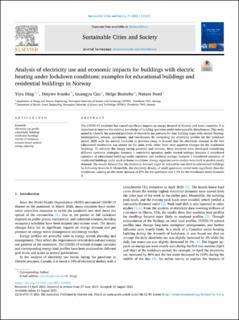| dc.contributor.author | Ding, Yiyu | |
| dc.contributor.author | Ivanko, Dmytro | |
| dc.contributor.author | Cao, Guangyu | |
| dc.contributor.author | Brattebø, Helge | |
| dc.contributor.author | Nord, Natasa | |
| dc.date.accessioned | 2021-11-03T08:31:33Z | |
| dc.date.available | 2021-11-03T08:31:33Z | |
| dc.date.created | 2021-08-19T10:41:04Z | |
| dc.date.issued | 2021 | |
| dc.identifier.issn | 2210-6707 | |
| dc.identifier.uri | https://hdl.handle.net/11250/2827440 | |
| dc.description.abstract | The COVID-19 pandemic has caused significant impacts on energy demand in Norway and many countries. It is important to improve the existing knowledge of building operation under unforeseeable disturbances. This study aimed to identify the potential problems of electricity use patterns for four building types with electric heating: kindergartens, schools, apartments, and townhouses. By comparing the electricity profiles for the lockdown period 2020 with the normal condition in previous years, it showed that the electricity demand in the two educational institutions was almost on the same level, while there were apparent changes for the residential buildings. To estimate the energy saving potential and increase, three scenarios were developed considering different operation strategies: Scenario 1 considered operation under normal settings; Scenario 2 considered operation of educational buildings under nighttime and weekend settings; Scenario 3 considered operation of residential buildings under work-at-home conditions. Energy signature curve models were built to predict yearly demand. The results showed that the electricity demand might be reduced by one-third in educational buildings by following Scenario 2. Meanwhile, the electricity density of small apartment varied more significant than the townhouse, causing an electricity increase of 27% for the apartment and 1.3% for the townhouse under Scenario 3. | en_US |
| dc.language.iso | eng | en_US |
| dc.publisher | Elsevier | en_US |
| dc.rights | Navngivelse 4.0 Internasjonal | * |
| dc.rights.uri | http://creativecommons.org/licenses/by/4.0/deed.no | * |
| dc.title | Analysis of electricity use and economic impacts for buildings with electric heating under lockdown conditions: examples for educational buildings and residential buildings in Norway | en_US |
| dc.type | Peer reviewed | en_US |
| dc.type | Journal article | en_US |
| dc.description.version | publishedVersion | en_US |
| dc.source.volume | 74 | en_US |
| dc.source.journal | Sustainable Cities and Society (SCS) | en_US |
| dc.identifier.doi | 10.1016/j.scs.2021.103253 | |
| dc.identifier.cristin | 1927190 | |
| dc.relation.project | Norges forskningsråd: 268248 | en_US |
| dc.relation.project | Norges forskningsråd: 267635 | en_US |
| cristin.ispublished | true | |
| cristin.fulltext | original | |
| cristin.qualitycode | 1 | |

